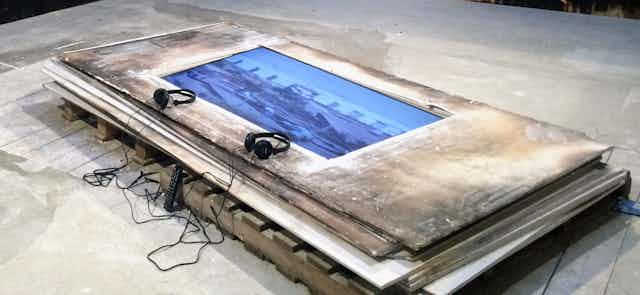Jesse Hlebo is troubled. The New York-based artist’s latest exhibition, In Pieces explores information overload and authenticity in the internet era – and it’s a challenging place to spend some time.
Walking into the gallery space in Fitzrovia is like opening a laptop to find three YouTube clips blaring at full volume and 16 tabs open on the browser.
In the middle of the room, a large screen projects an endless loop of amateur videos from crises around the world: conflict in the Ukraine, fighting in Gaza, the aftermath of the Boston bombing and the devastation left by Hurricane Sandy. The events flow seamlessly together, and the crises become increasingly difficult to distinguish. There’s no context or information; the audience is taken on a GoPro tour through a post-apocalyptic world, with no guide.
The loop captures some of Hlebo’s concerns about the internet’s vast media ecosystem: “In the amalgamation, there’s just so much,” he says. “There’s constant documenting, constant streaming … People don’t question its validity or where it comes from.”

Everyone’s a journalist
Hlebo is far from alone in his sense of unease. Over the past two decades, technology has radically altered media content, and raised a host of questions around authenticity, representation and power.
In the early 2000s, digital cameras and mobile internet access transformed everyday citizens into amateur journalists and the line between media producer and consumer started to blur.
As researcher and journalist Glenda Cooper notes, the Boxing Day tsunami of 2004 was a touchstone event in the rise of citizen-generated news content. There were almost no foreign correspondents in South-East Asia when the disaster hit – and the raw and powerful images captured by citizens and tourists came to dominate international news coverage.
For a few very short years, citizen-generated content was mediated by traditional news gatekeepers. Citizens would send their pictures and footage to a mainstream outlet: a wire service, the BBC, a newspaper. At these outlets, journalists could (potentially, but not always) contextualise and explain the content to their audiences.
And then came Twitter
The development and mass uptake of social media disrupted these processes once again. With Twitter, YouTube and Facebook, citizens become the distribution channels for media content.
When an aircraft miraculously landed on the Hudson River in January 2009, Jānis Krūms was on a nearby ferry. Instead of sending his now famous image to a news outlet, he uploaded it to Twitter where the picture went viral – 15 minutes before the “old media” had the story.
The event became known as Twitter’s “defining moment”, and media outlets realised they had, to a large extent, lost control of the message. Images and information could be uploaded, disseminated, replicated, decontextualised and re-purposed ad infinitum.
In 2012, Hurricane Sandy became the archetypal example of our new media ecology. Millions of photos were uploaded and endlessly circulated online. Some were authentic. Others were of historical weather events, cut-and-paste from fictional movies or dramatically edited on photoshop. And inevitably (this is the internet) there were cats.
The high circulation of de-contextualised and unverified images remains problematic. On January 12, photos purporting to depict a Boko Haram attack in Northern Nigeria last summer were revealed to be re-circulated images showing the aftermath of a fuel tanker explosion in the Democratic Republic of Congo.
The organisation stopfake.org has identified a number of false images in high circulation about Ukraine. One particularly dark image, claiming to show a morgue in Ukraine, was taken five years ago in Mexico. In their redistribution, these photos are infused with new meaning, and can become significant political tools.
And such issues have been widely noted in content about Syria, calling into question the credibility of both traditional and social media depictions of the crisis.
The promise of new voices
Of course, it’s not all bad. The liberation of images from traditional storytellers has also opened up huge opportunity. Social media played a pivotal role in the Arab Spring, which academics are still working to understand. And it allows audiences to challenge dominant representations in the mainstream media. In Kenya, for example, the hashtag #SomeonetellCNN was used to effectively critique and parody a problematic CNN report, leading to an apology and eventual retraction.
The power and potential of social media is explored in the second screen that dominates Hlebo’s exhibition. The amateur film – also very difficult to watch – shows Michael Brown’s mother receiving the news that the police officer who killed her son would not be indicted.
The mother’s raw anger tells a different side of the Ferguson story. For Hlebo, it reflects the potential of narrative unleashed from the traditional channels:
To see a mother receive that information in front of the world, without mediation, the power of that. We’re seeing it. It may have taken 270 years. But we’re seeing it.
Around the walls of the gallery hang pieces of Hlebo’s art that were damaged by a demolition team knocking down his Brooklyn flat. The pieces are black and burned, with only a passing resemblance to their original form. Their significance? Entirely up to the viewer.

